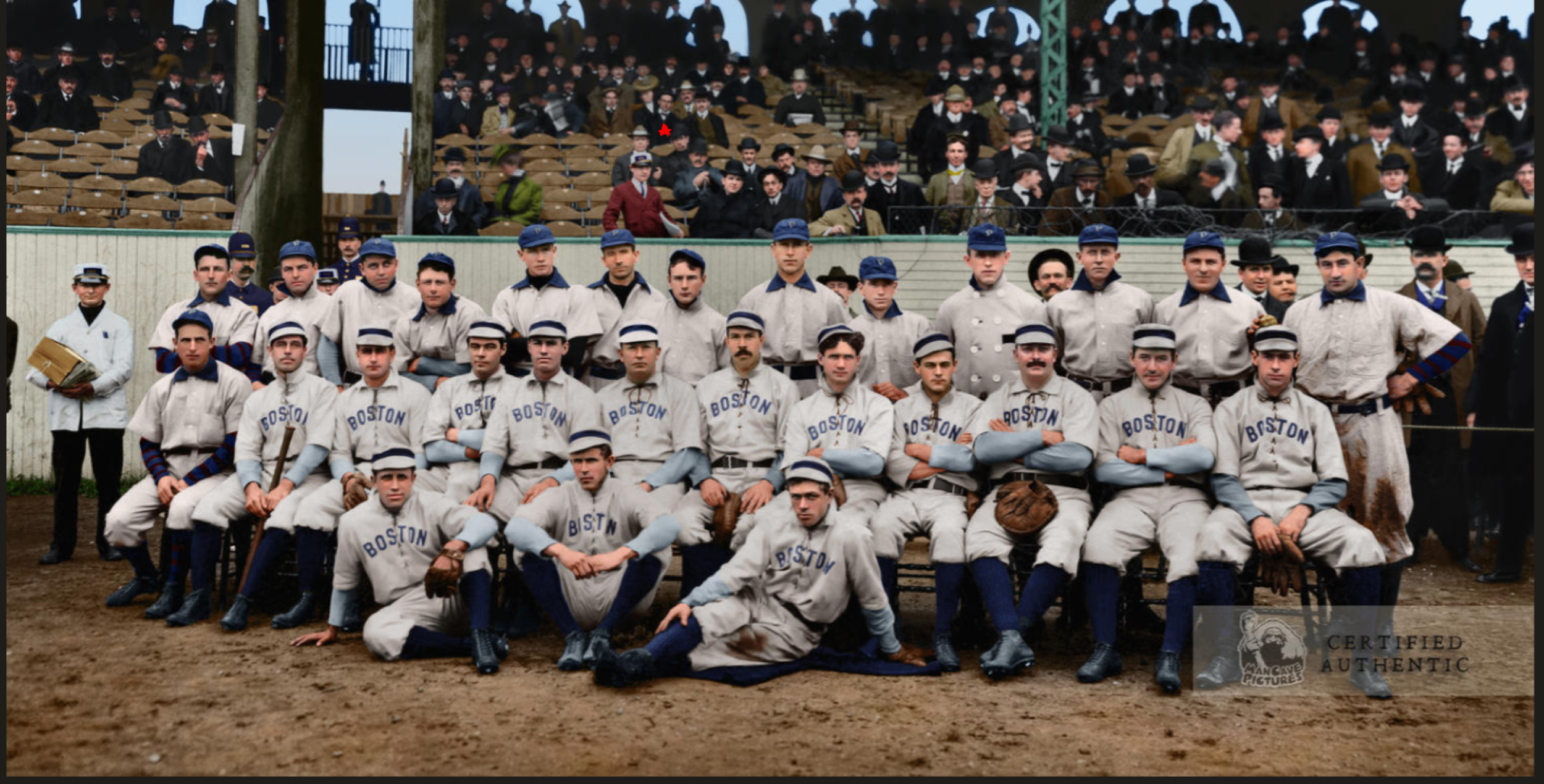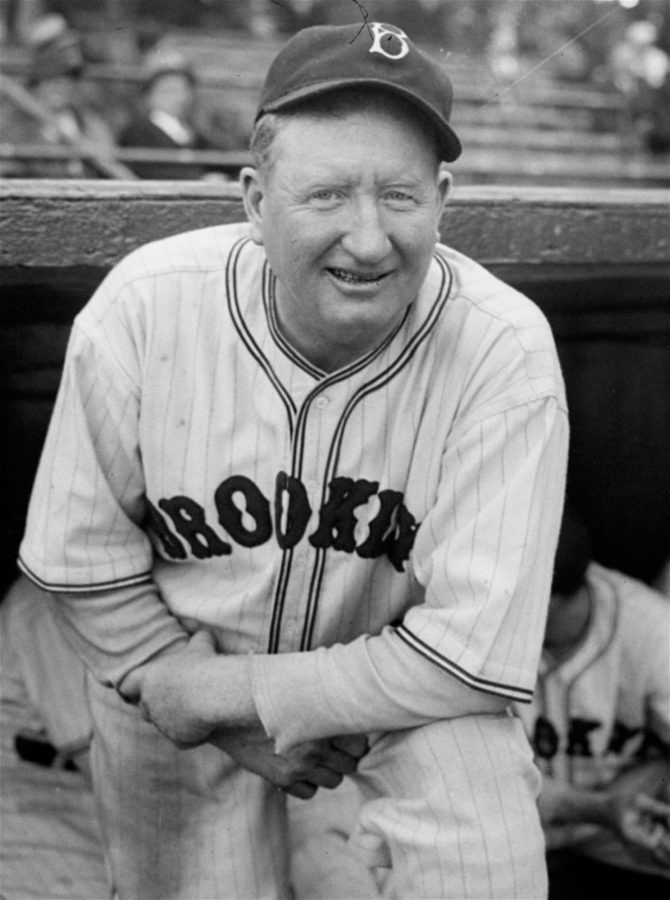Featured Photo Above:
Combined 1903 World Series Photo: Pittsburgh Pirates and Boston Pilgrims
(Color Restoration by Chris Whitehouse of Mancave Pictures)
Baseball History Comes Alive Now Ranked As a Top Five Website by Feedspot Among All Baseball History Websites and Blogs!
(Check out Feedspot's list of the Top 35 Baseball History websites and blogs)

Guest Submissions from Our Readers Always Welcome! Click for details
Scroll Down to Read Today’s Essay
Subscribe to Baseball History Comes Alive for automatic updates. As a Free Bonus, you’ll get instant access to my Special Report: Gary’s Handy Dandy World Series Reference Guide!
Michael Keedy’s “Mystery Player!”
Editor’s Update: Of course, it’s no “mystery” that Michael Keedy’s “Mystery Player” was none other than the great Dodger Hall of Famer, Dazzy Vance! See him in action with the great pic below!

(Today, Michael Keedy returns with the first of what we hope will be an ongoing series. He sends an interesting essay highlighting his first “Mystery Player.” As the name implies, we won’t reveal the name of the player right away. We’ll let you read through the hints Michael presents in the essay. Shouldn’t be too hard for our many “seasoned” readers. Come back tomorrow for the identity of the player and our usual photo gallery tribute to go with it. Should be fun! In the featured photos above and below, we see the ballpark where our Mystery Player had most of his success-GL)
Baseball fans old and young are familiar with the careers of Hall of Famers and other coulda-shoulda icons who broke from the gate in spectacular fashion in their late teens or early twenties, threatening to re-write the record books of our national pastime by their mid-thirties at the latest. Some, blessed with years of sound health and sustained excellence on the field, lived up to (or even exceeded) the intoxicating promise of youth and were ushered summarily into Cooperstown shortly after their retirement. (See, for example, Cobb, Mays, Aaron, Musial, Wagner and Speaker, to name just a representative handful.)
Other, equally bright flames flickered out in mid-career or far earlier, prompting historians and statisticians to extrapolate the might-have-beens out of tragically aborted athletic careers. (Think Dean, Cochrane, Conigliaro, Spooner, Bostock and Reiser – and we’re only scratching the surface here.)
But the most intriguing records of all belong to that rare and endangered species of ballplayer: The future Hall-of-Famer whose early accomplishments in his professional career lay hidden so far beneath the sonar that not even the savviest scout, numbers guru or professional prognosticator could have imagined he was destined for eventual induction into the hallowed halls of Cooperstown. Can you think of a couple? One?
Back in the dim reaches of Twentieth Century America, a rookie, right-handed power pitcher with exactly zero major-league victories to his credit celebrated his thirty-first birthday. (“Game over,” you say?) A flame-throwing starter with a chronically and mysteriously bad arm, he had spent almost the entirety of his twenties and beyond mired in the low minors. For purposes of this essay we shall call him “Charles,” for the very good reason that that was his given name. (You know him, perhaps, by his far more recognizable nickname.)
In 1921, Charles found himself hurling for the New Orleans Pelicans, a celebrated club fondly remembered by several I am sure, right down to this day. He was thirty years old, and still dreaming of his tantalizing and elusive first major-league win. On an early morning at the beginning of a new season in the minors, Charles banged that sorry right arm of his against a card table somewhere in The Big Easy while anxiously raking in the spoils of a winning poker hand. (“Fade to black”?)
More than 100 years later, we don’t know exactly what a treating physician in Louisiana did to that arm, but the odds and a pinch of hindsight from the budding world of sports medicine suggest he may have removed bone chips (not poker chips) from the ailing elbow of Sir Charles on this historic occasion. His ticket-to-ride now successfully punched at any rate, Charles was able to notch his first twenty-win season since he was a fresh-faced 23-year-old, back in 1914. He had posted 133 wins across ten promising but modest minor-league seasons and was now ready for The Show – not to mention middle age.
The Pelicans promptly sold Charles to the Brooklyn Robins for the ’22 season, and Charles promptly marked his 31st birthday, on March 4. He was getting old in a hurry! (It happens to us all.) Carrying the dismal baggage of an oh-and-4 won/loss record in the majors into what was officially his rookie year, Charles reeled off 18 wins for Brooklyn, leading the National League in strikeouts. Next on his fabled agenda: Birthday No. 32.
In his first four years in the major leagues, Charles rang up 86 wins. In each of his first seven seasons, by the end of which he was pushing 38 years of age, he led the league in strikeouts. Beating out Rogers Hornsby and his all-time best, .424 batting average in 1924, Charles rode his 28-and-6 record to the National League’s MVP award, leading the league in wins, ERA (2.16), strikeouts (262), and complete games (30). Pitching’s Triple Crown, in other words, plus one additional category for good measure.
Through 1925, Charles did some other remarkable things as well. He set the National League record for strikeouts in a nine-inning game (15) against the Cubs on August 23, 1924. The next season he fanned 17 Cardinals over ten innings. In September of ’24, he became the sixth big-leaguer in history to throw an “immaculate inning,” a phenomenon previously dissected by Dr. Gary Livacari on this very blog. He no-hit the Phillies, in 1925.
As mentioned, Charles opened his major-league career by leading the league in strikeouts seven consecutive seasons, an all-time National league record. He led the majors in wins in 1924 and ’25. He was the league’s ERA leader in ’24, ’28, and ’30.
Genuine students of the game will attest that it’s one thing to beat out all comers in a major category, and quite another to leave one’s competitors in the dust; mere “afterthoughts” as it were. (Think how the Mighty Babe annihilated his contemporaries’ home-run stats in the 1920s.) In many ways, our late-blooming Charles was to big-league pitching in the Roaring Twenties what Ruth was to power-hitting in that star-studded era.
By the start of the 1934 World Series, at age 43, Charles had joined the Gas House Gang in St. Louis, where his odd nickname fit so well with those fabulous Dean Brothers, otherwise remembered as Dizzy and Daffy. (Are you with me now?)…
Michael H. Keedy
Subscribe to our website, “Baseball History Comes Alive!” with over 1200 fully categorized baseball essays and photo galleries, now closing in on the one million hits mark with 935K hits and over 800 subscribers: www.baseballhistorycomesalive.com



Dazzy Vance has long been one of my favorites. Over the years I’ve noticed that some promising pitchers don’t “put it all together” until they reach age 30 or thereabouts. But I can’t think of any who succeeded as well as Vance did from age 31 on.
I can think of one…but we might have to wait for Michael’s next installment to find out his name!
A thousand pardons — or at least a couple. Dr. Denny was not misled, but in saying that our Charles led the National League in wins, ERA, strikeouts and complete games in 1924, I should have said he led the major leagues in all four of those categories. Sort of amazing, given his so-so credentials in what ought to have been the prime of his career.
You go, David!
Michael
I knew it from Vance being featured in the Ken Burns episode on the 30’s. After I first watched it, I read up a bit on Vance…. quite a character.
Supremely eloquent as usual, Sir Keedy.
But Charles Arthur, according to baseball ref, did not lead the majors in ERA in ’24. I’m sure it’s a technicality. However, a pitcher named Brown led all with an ERA of 2.00 that year. I hit a road block (maybe my cement head) and can’t deliver any more clarity. Can you enlighten us?
Thanks,
Van Lingle Mungo
Hello Bill,
Are you perhaps thinking of one (1) Dave K. Brown, who pitched in the Negro Leagues in the 1920s?
Regards,
Michael
You are correct, Sir!
And it’s good the Negro Leagues are getting more recognition. Most agree the stars would have excelled in the majors also. But there was a matter of depth, in those teams, which was not quite the same.
So, baseball reference should have a bold italic for our boy’s ERA in 1924, indicating he led both the American and National leagues, not just the National.
It is, however, my distinct honor to award you the SABCA (Schaefer Always Be Curious Award).
Michael, you will receive a card with your name, affixed with a large asterisk. Presented at any store this will entitle you to buy goods marked at one dollar, to be purchased by you, for $1.10. (merchant’s eyes will light up when they see you coming).
Can I have one too?? Afterall…
Of course, Gary, you shall receive one also. Except in your case, items marked at one dollar, purchased by you, will only cost you $1.00. Afterall…a boss is entitled!
You guys are cards! Baseball cards.
Worth a fortune.
The following wrap-up on Charles, which was omitted from our article yesterday when BHCA was treating him as a total mystery, might now be included:
“In his 1949 poem, ‘Line-Up For Yesterday,’ Ogden Nash put it this way:
‘V is for Vance,
The Dodgers’ own Dazzy;
None of his rivals
Could throw as fast as he.’
“Charles Arthur (‘Dazzy’) Vance, winner of 197 games over a seriously-delayed and woefully brief major-league career, went into the Hall of Fame in 1955, with 82 percent of the ballots. He was nearly 70 years old when he died, in Homosassa Springs, Florida, in February of 1961.”
Michael
Thanks for reminding me, I forgot to put that back in. It’s in there now.
Love Ogden Nash, “Candy is dandy, but liquor is quicker.”
Haha! Good one!
Boys, Boys!
Ogden Nash, judging by my literary meanderings/memories, did not say it.
I’m sure it’s a technicality. However, Francis Bacon thought it, said it, and wrote it, long before The Rambler was ever born.
I hit a road block! (Maybe my cement head.) I can’t deliver any more clarity.
Or confusion for that matter.
Can you two bums enlighten me?
Miguelitoloco
P.S. What was the topic again?
What the bleep are you talking about, Mr. Wiseguy? I’ll have you know, I knew Francis Bacon personally and he admitted he stole the line from Nash.
You make me think too much and now my head hurts. I’ll have to read about the Mets now to ease the pain.
Oh, wait a minute, I better go to my archives and cue up The Best of Bob and Ray instead!
Miguelitoloco is the perfect moniker for you–right, Gary?
Absolutely! I agree!
I give, gentlemen!
The final score: Nine to zip.
/s/ Laying An Egg With Bacon